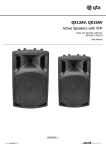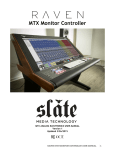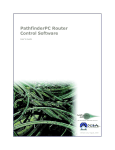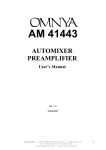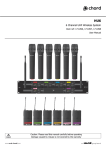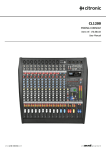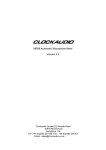Download SC-2A Manual
Transcript
SC-2A Stereo Corrector Videoquip Research Limited 595 Middlefield Road, Unit #4 Scarborough, Ontario, Canada. MIV 3S2 (416) 293-1042 1-888-293-1071 www.videoquip.com 1 Phase 3 SC-2A User Manual The Phase 3 Stereo Corrector allows the user to modify the input phase and output switching configuration of an incoming stereo audio signal. Figure 1 shows the front panel switch arrangement, as well as the alternate functions for each pushbutton in setup mode. The rear panel provides two XLR-3F connectors for the stereo input signal, and two XLR-3M connectors for the output signal. The output signal level amplitude may be trimmed with an adjustment potentiometer for LEFT and RIGHT output. There are two modes of operation available manual and auto. In MANUAL mode, the user may choose to invert the phase of the RIGHT channel input using the PHASE pushbutton. An LED associated with each pushbutton will indicate the status of each function. When the phase of the right channel is not inverted, the LED on the PHASE key will be off, and when the phase has been inverted, the LED will be on. In addition, the output modes available are Left/Right swap which is designated with the L ÅÆ R symbol, Left Only, Right Only, and Mono sum. The SC-2A also provides an automatic mode of operation, whereby it will examine the phase and amplitude of an incoming stereo audio signal, and will make corrections to phase and output status as it deems required. The SC-2A will default to AUTO at power-up to ensure that it returns to that mode of operation during a power failure, after the power is restored. This is indicated by the green LED associated with the MAN/AUTO switch being on. Pressing the MAN/AUTO key will place the SC-2A in manual mode, as indicated by the red LED being on. The user may toggle back and forth between manual and auto mode simply by pressing the MAN/AUTO key to select the desired mode. In the event that a correction is required, an alarm buzzer located inside the device will sound to alert the user that a correction has taken place. 2 When the SC-2A corrects a phase reversal, the alarm will sound briefly to alert the user, but the alarm will cease since the phase has been inverted. The SC-2A monitors the level of the incoming stereo signal and compares it to a preset level selected by the user during setup. If either the left or right channel of the incoming signal falls below the threshold for a preset time (silence interval) then the output will switch to the remaining signal that is above the silence threshold. For example, if the left channel falls below the silence threshold and remains there at the end of the selected silence delay, the right channel will be switched to both outputs. In addition, the RIGHT only LED will be on, and an alarm will sound. This implies that the right channel will be routed to both outputs for the duration of the left channel silence. If the missing left channel returns to a level above the silence threshold, the alarm will cease, and the routing will return to its previous state. The alarm buzzer may be muted by pressing the CANCEL pushbutton if it is currently on and the correction is still active. The selection of the silence level and delay timeout will be discussed later in the section entitled Calibration and Setup. Method of Operation This section will outline briefly the method by which the SC-2A detects and corrects phase and signal level problems to allow the user to better understand the limitations of the phase correction signal processing hardware and software. The basic theory behind the phase detection engine as implemented in software is that the Left Plus Right (LPR) signal should be greater than the Left Minus Right (LMR) signal when the phase is not inverted. The left and right signals are both added and subtracted in analog hardware, and followed by an appropriate peak signal detector for each. The peak detector provides appropriate attack and decay times, and gain structure to allow each one to be converted to a digital signal by an A/D converter inside the microprocessor. The reliability of the phase detection engine depends primarily on the type of program material. By observation, it also depends largely on how a particular music track was mixed. Popular music is mixed primarily with strong center channel information such as vocals, bass guitar, main guitar, and kick drum. Other instruments including background vocals and other instrument fills are frequently panned either left or right to provide a sense of stereo image. Main vocals are frequently mixed with reverberation tails cross-panned to left / right to provide a sense of depth as well. Compression helps to provide a “punchy” signal suitable for radio airplay. Classical or symphonic music however, is best recorded with a stereo MS pair high above the musicians, with little or no compression to preserve the dynamic range to provide a sense of realism to capture a true “live” sound. Consequently, there is not a great deal of center channel information of sufficient amplitude to allow a significant difference between LPR and LMR. 3 The SC-2A looks for a window between the LPR and LMR of sufficient difference to allow an accurate determination of phase between left and right channels. The detection window size is adjustable in real-time via the delay potentiometer on the front panel of the SC-2A. Figure 2 below shows the effect of this adjustment. Figure 2 and Figure 2a above, show a graphic representation of the type of output from the LPR and LMR . A correct window size for popular music as shown in Figure 2a, will be inadequate for classical or symphonic music since the difference between LPR and LMR is too narrow to cause the window to trigger properly. Setting the threshold too low may result in false triggering of the phase detection mechanism, since the LPR and LMR are independent and will frequently rise and fall at slightly different rates and amplitudes. Figure 2 and 2a above, depict a situation where the window setting is a good choice for popular music, but is set too high for classical music. This graphic representation helps to visualize the operation of the phase detection software. Figure 2 shows a window size set essentially too wide to properly detect classical or symphonic music. In general, great care must be exercised in setting the window size. The SC-2A will provide reliable operation when the window size is adjusted properly for popular music, and will require a narrower window for classical music. In general, the so-called “signature” for popular music in Fig 2a reflects the fact that popular music contains a significant amount of center channel energy. This energy is more or less in phase, which results in lower LMR energy, since it cancels when subtracted, but adds to the LPR energy level. If the LPR energy level exceeds the window setting and is out of phase, the SC-2A will always accurately detect and correct incoming phase reversals, as soon as they are encountered. With classical music, the lack of strong center channel information that is inphase and can cancel to push the LMR energy down to allow a wider detection window is the main limitation with this method of detecting phase. Note that the SC-2A software is looking for the relationship between LPR and LMR, and is not level dependent. 4 Calibration and Setup The calibration and setup of the SC-2A falls into two categories, default and operational. Power-up Defaults Setup Setting the power-up defaults is a procedure that is done with a special setup state. To enter the setup mode, hold down the MAN/AUTO switch while turning on the power switch, and then release the MAN/AUTO switch. The red and green LED’s associated with this switch will flash alternately back and forth to alert the user to the fact that the SC-2A is in setup mode, since in normal operation this action will not occur. The normal pushbutton key functions are modified in this state to allow the user to set the parameters of operation with the same keyboard. Figure 3 shows the alternate key functions during setup mode. Two parameters may be selected during this setup mode. 1) Silence Detection Level – Uses the L Å Æ R, LEFT, RIGHT and MONO switches to set the silence level. Signals below these levels in either left or right channel are interpreted as being silent after the silence timeout interval has expired. Refer to Figure 3 to select one of four silence level selections. 5 2) Silence Timeout Delay – Uses the MAN/AUTO and CANCEL pushbuttons to allow the user to set the silence timeout with a wristwatch or stopwatch. The front panel delay potentiometer allows the user to set a silence delay timeout from approximately 2 seconds to 60 seconds before the silence alarm triggers and the appropriate LEFT or RIGHT only audio function is enabled. When the audio signal in the missing channel returns to a level above the threshold, the alarm is automatically cleared and the output setting returned back to its previous state. Note that if L Å Æ R swap was engaged, that state will be preserved during this operation. Setting the Timeout Delay The timeout delay uses the front panel DELAY potentiometer to set the delay, and the resulting delay from the position as it is rotated is used to adjust the overall time delay. If the pot is in the CCW position fully, the delay will be minimum, and the delay will be maximum at full CW rotation. In order to estimate the actual value, the flashing LED’s on the MAN/AUTO switch are used to provide visual feedback. As the potentiometer is rotated to a different position, press the CANCEL pushbutton on the front panel. The LED’s associated with the MAN/AUTO switch will stop flashing, and the green LED will be fully ON during the duration of the timeout. When the timeout has expired, the LED’s will return to the flashing mode of operation waiting for a new trigger from the CANCEL pushbutton. If the desired time delay has been exceeded with the rotation of the potentiometer, it is not necessary to wait for the end of the timeout to set a new value. Pressing the MAN/AUTO pushbutton will abort any timeout in progress and wait for a new trigger. If for example the user wished to set the timeout to 30 seconds and the green LED was still on past the 30 second mark on the stopwatch, simply press the MAN/AUTO button to cancel that timeout. Adjust the pot to a lower setting, and trigger the timeout again with the CANCEL pushbutton. When the desired timeout has been selected, press the PHASE key to save the selected timeout value, and the desired silence detect level to the EEPROM memory on the main board. Each time the SC-2A is powered on, the saved values will be restored from EEPROM. Since the front panel DELAY potentiometer is not involved in setting the time delay on an on-going basis, it will free the potentiometer for the real time selection of the phase detection window. 6 To return the SC-2A to normal operation, simply turn off the power switch, wait approximately 5 seconds to allow the power supply to return to zero internally, and then turn on the power again. The unit will power-up ready for operation in the AUTO mode of operation. NOTE: It is recommended that the silence timeout delay be set to approximately 1 to 3 seconds initially, since the window size adjustment for phase will require a short delay to see the effect of changing the window size. THE SILENCE TIMEOUT DELAY ADJUSTMENT SHOULD BE DONE AFTER ADJUSTING THE WINDOW SIZE, SINCE THE POTENTIOMETER IS ALSO USED FOR THE WINDOW SIZE ADJUSTMENT IN REAL TIME. Operational Setup The operational setup involves simply trimming the output levels with the OUT R and OUT L trim potentiometers located on the front panel of the SC-2A. They provide approximately 3 dB of trim adjustment. Select MAN mode (red LED on) for this adjustment to prevent the phase and silence detection to operate. It is important to try to trim the output levels while connected to the upstream equipment if it is possible. The detection circuitry is taken after the trim adjustment and any mismatch in the levels will affect the quality of the LMR null. WINDOW SIZE ADJUSTMENT 1) After the level trim setup is done, connect a source of audio to the SC-2A with cables of known good phase (no inversion). The nominal operating level of the SC-2A is + 4 dBu. 2) Turn the DELAY potentiometer fully clockwise (CW to the right) with the desired music track connected to the SC-2A. To disable the auto phase correction completely, simply keep the DELAY potentiometer fully clockwise to make an arbitrarily wide window that cannot trigger a phase correction. 3) Press the PHASE pushbutton. The LED for that button should be on. We will be using the phase reverse function to allow the phase detection software to flip it to good phase when the window is at the correct level for the source type. 4) Select AUTO operation. Note that all pushbuttons are disabled in AUTO operation. 5) Rotate the potentiometer very slowly CCW until the LED associated with the PHASE pushbutton turns off. Because we artificially introduced a phase inversion by manually changing the phase in step 3, the SC-2A is correcting the phase in auto mode back to where it believes it should be. 7 6) Visually make a note of the position of the potentiometer. There is currently no provision to store the window size in EEPROM memory. The phase detection software will always use the current position of the potentiometer as the window size when the SC-2A is operating in AUTO mode. When the Silence Delay Timeout adjustment is performed, the potentiometer will have to be returned to the current position for window size. 7) Set the Silence Timeout Delay as described in step 2 on page 6. 8) Re-set the potentiometer to the desired window size as determined previously on page 7. The SC-2A should be functional in AUTO mode at this time. To test the unit after this, it may be desirable to fabricate a special cable that will provide a switch that will allow phase inversions to be introduced by the user at will, thereby making further adjustments much easier. A suggested schematic is shown in Figure 4 below. S1 J1 XLRF-3PIN 2 2 3 3 1 1 SW DPDT Fig 4 - Suggested schematic for a phase inversion cable between one output and one input of the SC-2A for introducing simulated phase inversions. The switch should be a latching type pushbutton switch. Shown in the normal phase (switch out) condition. 8 J2 XLRM-3PIN SC-2A Specifications Power Requirements 115 VAC, 60 Hz or 230 VAC, 50Hz, 6W Analog Audio Inputs Input Impedance Maximum Input Level Input Connectors Common Mode Rejection 40 Kohms balanced, 20 Kohms unbalanced +21 dBu XLR-3F, x 2 -70 dB @ 60Hz Analog Audio Outputs Output Impedance Output Signal Level Output Connectors 100 Ohms balanced +4 dBu nominal XLR-3M, x 2 Frequency Response THD + Noise Hum and Noise 20 Hz to 20 KHz +/- 0.25 dB 0.03% or less @ 0 dBu -70 dBu, with 22 KHz LPF in measured path Adjustments Output Level Silence Timeout Delay +/- 3 dB trim range Approximately 2 -> 60 seconds, front panel DELAY potentiometer, saved in EEPROM. Phase Detection Window Size Variable via front panel DELAY potentiometer Providing real-time adjustment of window size. 9 Warranty Videoquip Research Limited (VRL) warrants the SC-2A for a period of 2 (two) years from the date of shipment from the factory, to be free of defects in workmanship and material under normal use and service. This warranty is void if failure is due to abnormal use or modification, or if serial numbers have been tampered with. VRL’s liability is limited to the repair or replacement of this unit, or to a sales credit, and the warranty action taken is at the sole discretion of VRL. Any warranty claims must be received in writing by VRL before the expiration of the two year period. Warranty coverage does not include shipping costs. This warranty is in lieu of all other warranties, expressed or implied, and all other obligations or liabilities of Videoquip Research Limited. 10












